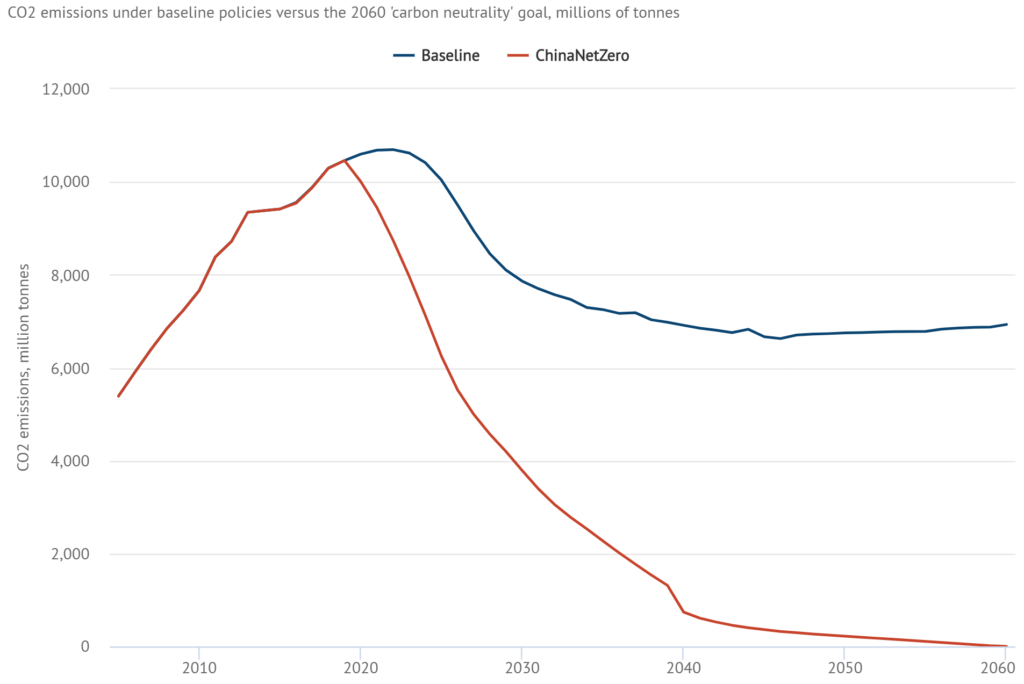(Picture: unsplash.com)
At the 75th United Nations (UN) General Assembly held in September 2020, China pledged to reach CO2 emissions peak before 2030 and achieve carbon neutrality before 2060. (Source: UN News)
This means that around one third of the world’s CO2 output has, overnight, been committed to net-zero emissions within 40 years. China’s pledge could curb this century’s global warming by 0.25°C, reaching around 2.35°C. (Source: Carbon Brief) If achieved, this would be the biggest reduction in projected global warming of any climate commitment made so far, according to Climate Action Tracker (CAT, a research consortium). (Source: Reuters)
According to Carbon Brief, in order to succeed in its goal to reach net-zero CO2 emissions by 2060, China will have to implement a whole range of policies:
- Foundations: a combination of energy efficiency rules and carbon pricing, based on China’s emerging emissions trading scheme
- Technology: introduce policies to support the development of specific technologies that accelerate existing trends, such as feed-in tariffs for renewables (whereby producers of renewables are paid an above-market price) or subsidies for electric vehicles
- Coal: ensure no new coal plants are built, stressing the fundamental role of regulation in guiding markets towards net-zero
This strategy would avoid releasing 215 billion tons of CO2 over the next 40 years:

Modelled CO2 emissions in China under existing policies and technology trends (baseline, blue line) versus a pathway to net-zero by 2060 (ChinaNetZero, red), millions of tons of CO2. Source: Cambridge Econometrics modelling.
(Source: Carbon Brief)
Global impact and spillover effects
China’s climate strategy is also projected to have a positive impact on its economy, as the enormous investments required to implement it would raise China’s GDP by as much as 5% before 2030.
These massive investments would also have the effect of lowering the cost of clean energy, thereby creating a positive “spillover” effect around the globe. A good example in support to this claim is that we have seen this already with solar panels: high levels of demand for solar panels in China have driven down prices around the world.
This is reassuring news, as it means that even if the rest of the world won’t follow China’s ambitious example and implement bolder climate policies, emissions would still fall in other countries. China’s pledge will also create a surge in the global demand for financial analysts that are able to correctly value alternative assets from an environment, social, and governance (ESG) perspective. With more available information on assets value, information asymmetry will be reduced and investors will be able to make more informed decisions. This will positively impact the sustainable finance and impact investing industry, as it will become more transparent and will be delivering higher returns to investors.
The spillover effects are however not all positive. China’s decarbonization would reduce demand for oil, global prices would fall, and as a consequence the transition to electric vehicles outside China would slow down (assuming no policy interventions to counteract this negative trend). (Source: Carbon Brief)
Impacts on the job market
The Chinese government is expected to lay out more details in its next five-year plan in March 2021. According to the Global Times, UBS economists believe that
- China will increase non-fossil energy’s share of total energy consumption from 15% (a target that was set for 2020) to 18%
- China will further reduce its energy use per unit of GDP and CO2 and SO2 (sulfur dioxide) emissions
- Demand for equipment, services and investment will continue to grow at a faster pace
This analysis, combined with the focus on the following points, make a strong argument in support of the fact that the “2060 pledge” made by China will have a net positive impact on the labor market. In fact, for China’s carbon neutrality pledge to be honored, the nation will need to focus on:
- Manufacturing: increasing the share of solar and wind energy
- Infrastructure: innovate away from carbon-intensive infrastructure projects
- Research & Development: enhancing its R&D commitments in renewables, which among other include hydrogen energy, carbon capture at scale, and carbon storage technologies
It is expected that, in the context of the next five-year plan, the different regions of China could design their own plans in accordance with local economies. This would allow them to neutralize the increase in unemployment created by curbing emissions in certain sectors by boosting other green growth-enabled businesses.
(Source: Global Times)
Call for unity
With its announcement at the UN General Assembly, China has laid down a milestone and sent a strong, positive signal in a moment where many other countries are doubting their climate commitments.
China stated that to preserve the environment we need to unite and cooperate to enact a green revolution and transition to a low-carbon world by following the guidance of the Paris Agreement on Climate Change. (Source: UN News)
Let us know your thoughts in the comments section of our LinkedIn post!
You can go more in depth on the topic by reading the following:
UN News: “Enhance solidarity’ to fight COVID-19, Chinese President urges, also pledges carbon neutrality by 2060”

